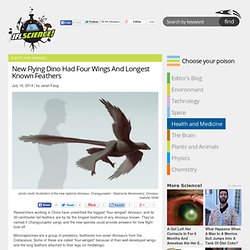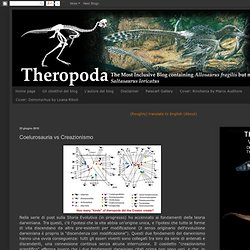

Birds Evolved From Dinosaurs Gradually, Capped With Diversity Burst. We can stop looking for the missing link in the dinosaur-bird transition now because it was seamless.

Birds are a continuum of millions of years of evolution, and there was no great jump between non-birds to birds. “There was no moment in time when a dinosaur became a bird, and there is no single missing link between them,” says University of Edinburgh’s Steve Brusatte in a university statement. “What we think of as the classic bird skeleton was pieced together gradually over tens of millions of years. Once it came together fully, it unlocked great evolutionary potential that allowed birds to evolve at a super-charged rate.” Da dinosauri a uccelli: 50 milioni di anni di miniaturizzazione. La corsa evolutiva da grandi rettili a uccelli. La corsa alla speciazione degli uccelli New Flying Dino Had Four Wings And Longest Known Feathers. Researchers working in China have unearthed the biggest “four-winged” dinosaur, and its 30-centimeter tail feathers are by far the longest feathers of any dinosaur known.

They’ve named it Changyuraptor yangi, and the new species could provide answers for how flight took off. Microraptorines are a group of predatory, feathered non-avian dinosaurs from the Cretaceous. Some of these are called “four-winged” because of their well-developed wings and the long feathers attached to their legs (or hindwings). “Numerous anatomical features and behaviors that we have long associated with birds in fact evolved in dinosaurs long before the first birds arrived on the scene,” study coauthor Alan Turner from Stony Brook says in a news release. Coelurosauria vs Creazionismo. Nella serie di post sulla Storia Evolutiva (in progresso) ho accennato ai fondamenti della teoria darwiniana.

Tra questi, c'è l'ipotesi che la vita abbia un'origine unica, e l'ipotesi che tutte le forme di vita discendano da altre pre-esistenti per modificazione (il senso originario dell'evoluzione darwiniana è proprio la "discendenza con modificazione"). Questi due fondamenti del darwinismo hanno una ovvia conseguenza: tutti gli esseri viventi sono collegati tra loro da serie di antenati e discendenti, una connessione continua senza alcuna interruzione. Birdlike fossil challenges notion that birds evolved from ground-dwelling dinosaurs. The re-examination of a sparrow-sized fossil from China challenges the commonly held belief that birds evolved from ground-dwelling theropod dinosaurs that gained the ability to fly.

The birdlike fossil is actually not a dinosaur, as previously thought, but much rather the remains of a tiny tree-climbing animal that could glide, say American researchers Stephen Czerkas of the Dinosaur Museum in Blanding, Utah, and Alan Feduccia of the University of North Carolina. The study appears in Springer's Journal of Ornithology. The fossil of the Scansoriopteryx (which means "climbing wing") was found in Inner Mongolia, and is part of an ongoing cooperative study with the Chinese Academy of Geological Sciences.
It was previously classified as a coelurosaurian theropod dinosaur, from which many experts believe flying dinosaurs and later birds evolved. The research duo used advanced 3D microscopy, high resolution photography and low angle lighting to reveal structures not clearly visible before. Really, again? You’ve got to be fucking kidding me! I honestly don’t think I can write any more on how bad Alan Feduccia’s “science” is on the subject of bird origins than I already have, here.

The origin of birds. The origin of birds The discovery that birds evolved from small carnivorous dinosaurs of the Late Jurassic was made possible by recently discovered fossils from China, South America, and other countries, as well as by looking at old museum specimens from new perspectives and with new methods.

The hunt for the ancestors of living birds began with a specimen of Archaeopteryx, the first known bird, discovered in the early 1860s. Like birds, it had feathers along its arms and tail, but unlike living birds, it also had teeth and a long bony tail. L'origine degli uccelli. Gli uccelli conoscono i segreti per sopravvivere all’estinzione. La storia evolutiva degli uccelli non smette di sorprendere.

Nel 1860, la scoperta di Archeopterix lithographica, congiunzione una delle forme di transizione più note tra rettili e uccelli, ha dato le necessarie evidenze fossili ad alcune delle relazioni filogenetiche ipotizzate da Darwin. Questo essenziale reperto ha però anche aperto la strada a molte controversie successive sulla possibile discendenza degli uccelli dai dinosauri. La parentela tra i due gruppi è stato uno degli argomenti caldi nell’ambito della paleontologia e la sua comprensione è rimasta a lungo dibattuta a causa della scarsità di reperti fossili. Archaeopteryx lithographica. Aurornis xui: nuova luce sull'origine degli uccelli. Questo post ha un valore particolare per me, e non stupitevi se sarà forse un po' enfatico (oltre che più lungo del solito).

La giornata di oggi è difatti una delle più importanti nella mia altresì modesta carriera paleontologica: sul numero di Naturedi questa settimana è stato appena pubblicato l'articolo di un team internazionale del quale sono parte (comprendente Pascal Godefroit, me, Dong-Yu Hu, François Escuillié, Wenhao Wu e Gareth Dyke), che descrive ed istituisce un nuovo dinosauro theropode, dal Giurassico Medio-Superiore della Cina. Battezzato Aurornis xui, letteralmente, “l'Uccello dell'Alba di Xu Xing” (in onore del paleontologo che più di ogni altro ha contribuito allo studio dei dinosauri piumati), questo fossile risulta avere una combinazione di caratteri tale da suggerire un nuovo scenario, in parte inedito, per la transizione evolutiva che conduce ai primissimi uccelli.
Prologo autobiografico Da YTGP-T5198... Età. Autenticità dell'esemplare. ...ad Aurornis Epilogo. Early bird called Dawn beat Archaeopteryx to worm by 10m years. A prehistoric beast the size of a pheasant has become a contender for the title of oldest bird to stalk the Earth.

The small, feathered "Dawn" bird lived around 160m years ago, about 10m years before Archaeopteryx, which holds the official title of the earliest bird known to science. The new species, which scientists have named Aurornis xui, had claws and a long tail, with front and hind legs similar to those of Archaeopteryx, but some features of its bones were more primitive. It measured 50cm from its beak to the tip of its tail. Encased in sedimentary rock, the fossil preserved traces of downy feathers along the animal's tail, neck and chest, but the absence of larger feathers suggests it was not able to fly. Anno nuovo, paraviani nuovi. Rahonavis ostromi. Da Wikipedia, l'enciclopedia libera.

Il Rahonavide ("minaccia dalle nuvole") era un bizzarro dinosauro pennuto che visse in Madagascar durante il Cretaceo, 84-69 milioni di anni fa. Conosciuto per un fossile abbastanza completo, era in passato considerato una sorta di anello mancante tra dinosauri e uccelli. Uccello o raptor? [modifica | modifica sorgente] Scoperta e specie[modifica | modifica sorgente] Altri progetti[modifica | modifica sorgente] Commons contiene immagini o altri file su Rahonavis ostromi Voci correlate[modifica | modifica sorgente] Jeholornis. Sapeornis. Sapeornis is named for SAPE, the Society of Avian Paleontology and Evolution, added to the Ancient Greek όρνις (ornis), meaning "bird". chaoyangensis is Latin for "from Chaoyang". Description[edit] Size of S. chaoyangensis compared with a human The hand of Sapeornis was far more advanced than that of Archaeopteryx. It had three fingers, the outer ones with two and the middle one with three phalanges, and a well-fused carpometacarpus.
Its arms were about half again as long as the legs, suggesting a large wing area. The skull has a handful of teeth in the upper jawtip only. In absolute number of features shared with modern birds, S. chaoyangensis is about as advanced as Confuciusornis. "Orologi morfologici" e la comparsa degli uccelli moderni. Negli ultimi 25 anni, due ambiti apparentemente distinti come la biologia molecolare e la paleontologia hanno iniziato una complessa, a tratti burrascosa, relazione.
In molte analisi filogenetiche delle specie viventi, che utilizzano i dati "molecolari" (in particolare, sequenze di genoma) per ricostruire le relazioni tra le specie, i fossili sono utilizzati per calibrare il possibile tempo dell'evoluzione. Riassumendo al massimo questi metodi, la "distanza genetico-molecolare" tra le specie si può tradurre in "distanza temporale" tra le linee evolutive (ovvero, una stima del momento in cui queste si sono separate reciprocamente lungo l'evoluzione) utilizzando l'età dei rappresentanti fossili più antichi di queste linee come "calibrazione" dell'antichità delle varie linee evolutive.
L'ipotesi "molecolare" sull'origine di Aves colloca questo evento quindi a circa 30-40 milioni anni prima dell'età che si ottiene da una interpretazione "letterale" del record fossile. Andrea Cau Riferimenti: Origine degli uccelli: la rinvicita di Archaeopteryx.